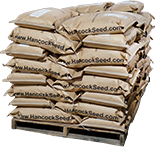H Type inoculant is recommended for Blue Lupine. This 5 oz package treats up to 100lbs.
Why do I need to Inoculate seed?
The air we breathe contains more than 78 percent nitrogen in the form of nitrogen gas (N2). Legumes have the unique ability to form a symbiotic relationship with rhizobia (Rhizobium and Bradyrhizobium) bacteria to convert atmospheric nitrogen gas to ammonia nitrogen, a form usable by the plant. This relationship occurs in specialized root tissue called nodules. Some legumes, such as alfalfa, can produce enough ammonia to supply all their nitrogen needs, hence nitrogen fertilization usually is not needed.
Information on Inoculating Seed
More and more people are interested in planting food plots for a variety of wildlife species. Unfortunately, few people understand what is involved to be successful. To begin, the planting must match the site (i.e., correct soil moisture, and temperature conditions). Next, the soil should be amended, as recommended from a soil test, for the plots to achieve their growth and nutritive potential. Assuming attention has been given to these factors, other details critical to success include seedbed preparation, inoculation and planting depth.
Many legumes (e.g., clovers, alfalfa, birdsfoot trefoil, soybeans, peas) are excellent choices for wildlife food plots. Legumes are plants that bear seed in a pod and have a symbiotic relationship with certain species of nitrogen-fixing bacteria (i.e., Rhizobium, Bradyyrizobium spp.). These bacteria attach themselves to the roots of the legumes and form nodules. From these nodules, the bacteria extract nitrogen from the air. Rhizobia obtain energy from the plant, while the plant receives nitrogen produced by the bacteria. Thus, both bacteria and plant benefit form the relationship. this phenomenon is important when planting wildlife food plots for three reasons: 1.) minimal nitrogen fertilization is required, 2.) nitrogen is not a limiting factor to properly inoculated plants and 3.) weed competition is reduced since little nitrogen fertilizer is applied.
Particular legumes require specific Rhizobia will inoculate all legumes. Therefore, it is important to use species-specific inoculant for for the legume being planted. Although Rhizobia, are found naturally in the soil, it is critical to inoculate seed prior to planting to ensure that the proper species of Rhizobia is in contact with the seed. Seed of many improved varieties of legumes may be pre-inoculated. This means that the seed has already been inoculated with the proper bacteria prior to bagging. Pre-inoculated seed is coated to protect the bacteria and usually has an off-white or pinkish color. Because the bacteria are present under the coating surrounding the seed, pre-inoculated seed do not need to be inoculated. Check the seed certification tag to determine if the seed has been pre-inoculated.
Properly inoculated seed may help Rhizobium produce up to 200 pounds of nitrogen per acre, depending on species of legume selected. This is very beneficial in reducing fertilization costs, especially when following a legume crop with a grass, such as corn, grain sorghum, wheat or oats.
*Product packaging may appear different than what is pictured.

If the seed is not pre-inoculated, certain procedures should be followed to ensure proper inoculation.
1.) Buy inoculant suited specifically for each legume planted. Inoculate has a limited life span, so it is important to check the expiration date.
2.) Never expose the package of inoculant to heat or direct sunlight (especially the dashboard of a truck), as this will kill the bacteria. To ensure viability, inoculant should be refrigerated.
3.) Most inoculants come packaged in a medium of peat, which is black. This material must be mixed with just enough water to form a "slurry."
4.) It is critical that the inoculant adheres to the seed. If not, the entire process may be useless. A commercial "sticker" should be used to stick the inoculant to the seed. Some sticking agents contain gum arabic, which is recommended for its ability to sustain high numbers of bacteria on the seed. If a commercial sticker is not available, a solution of four parts water to one part sugar can be used as a substitute. Do not use cola or soda pop as a "sticker" because the pH of most soft drinks is very low and the acid solution may kill the bacteria.
5.) Dissolve "sticker" in the water (if you don't use sugar water) and mix the inoculant as directed on the package to form a thick "slurry." Add slurry to seed and mix well, making sure all seeds are coated with inoculant. The coated seed should be allowed to dry in the shade. DO NOT place in the sun to dry. The seed should be dry enough to sow in about an hour.
H Type Inoculant - Lupine
H Type inoculant is recommended for Blue Lupine. This 5 oz package treats up to 100lbs.

Instructions
For more info on planting instructions and tips for the best results – check out our Warranty & Planting Information here!
If the seed is not pre-inoculated, certain procedures should be followed to ensure proper inoculation.1.) Buy inoculant suited specifically for each legume planted. Inoculate has a limited life span, so it is important to check the expiration date.2.) Never expose the...





















